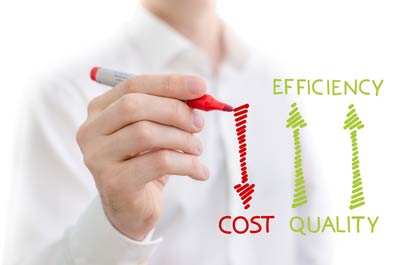 There’s one question that comes up in practically every call we have with prospects and customers lately. You’ve probably guessed it already: “How can we reduce cost?”
There’s one question that comes up in practically every call we have with prospects and customers lately. You’ve probably guessed it already: “How can we reduce cost?”
It’s a fact. Every buyer wants to pay less for their injection molded parts, but without sacrificing quality. Thankfully, for many jobs, this is achievable if you know where to look. But you must be careful to preserve the part’s quality and integrity in the process, otherwise it could cost you in the long run. As the old saying goes, don’t be penny wise but pound-foolish.
There are several areas worth examining to help reduce injection molded part costs. These include part and tooling design, material, and manufacturing process considerations. Let’s take a look at these to see how successful cost reduction can be achieved:
Part and Tooling Design
The first place to start is with part design. Ultimately, your goal is to simplify the part wherever possible, Or, as we say here in the shop, KISS, or keep it super simple. Technically speaking, this translates to simplifying the geometry, minimizing undercuts, and eliminating unneeded features. When design is properly optimized, less material will be consumed and cycle time reduced. Less design complexity leads to lower tooling costs.
Additional cost saving opportunities may be found in the tool design and construction. Optimizing cooling channels, or conducting a mold flow analysis to identify areas for improvement. You should also consider options for using standardized mold components. By optimizing the gating system and cooling channels, you may be able to further cut cycle time and reduce material waste.
Are You Using the Best Material?
Material selection presents another potentially large opportunity for cost reduction. In our experience, the material is often over-spec’d. For instance, it is not unusual to see a job that calls for a resin that is say $10 or $20/lbs., when it could be made from a commodity material costing just a few dollars per pound. For medium and larger runs, this adds up to significant savings. Of course, you must be certain that the new material still meets the required specifications and operating conditions for the part. But there is no benefit in over specifying, it is sort of like installing stainless steel muffler on the Yugo.
Process Considerations
To keep production costs in check, it is critical to be sure that the process is optimized during process development stage. Reducing cycle time has a major impact on part cost. It is also a good idea to routinely revisit and verify that your process is at its optimum, study quality data, and eliminate any sources of waste or defects.
Automation and Robotics to the Rescue!
Another cost-saving process enhancement is to utilize automation and robotics when possible. As we explored in our previous blog, automation brings many cost-cutting benefits. It is especially useful when complex assemblies may be faithfully produced with the help of reliable automation. This reduces labor costs, material waste and cycle time.
Don’t Forgot About the Economies of Scale!
When practical, consider ordering in larger volumes. It is a simple principle. As run size increases, unit cost decreases. When coupled with reliable forecasting, this could lead to healthy savings. Don’t have a lot of space to store components that you don’t need yet? Many shops will offer stocking programs to help with warehousing. Though do keep in mind that carrying inventory is not free, so consider these costs when weighing against the benefits of longer production runs.
As you can see, there are plenty of ways to reduce injection molded part costs. It all comes down to reducing labor costs and cycle time while increasing process efficiency. As we mentioned earlier though, please be cautious. While saving money is certainly a good thing, you don’t want to sacrifice the part’s required properties in the process, especially for mission or safety-critical applications.
Want to see if we can help you reduce molded part costs?
Give us a call, tell us about your part, or send a drawing. We’ll be happy to review it and let you know what find!

Comments are closed